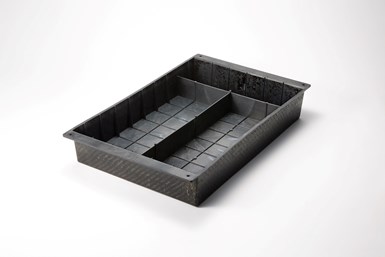Asahi Kasei presents circular composite solutions for EV batteries
Novel thermoplastic composite materials, a bio-based and biodegradable nanofiber and a technology that chemically recycles PA66 polymers enable more circular, lightweight and connective EVs.
Japanese technology company Asahi Kasei (Tokyo) presents its range of diversified material solutions for safe and compact electric vehicle (EV) batteries, improved connectivity and lightweighting, as well as a circular economy.
The company is currently developing a new continuous glass fiber-reinforced thermoplastic, Lencen, formed by stacking layers of continuous glass fiber textiles with polyamide 66 (PA66) films. Due to its tensile strength, high heat resistance and impact properties similar to metal, the company says its use improves collision safety and weight reduction of EV batteries. A carbon fiber-reinforced thermoplastic (CFRTP) unidirectional (UD) tape uses recycled continuous carbon fiber and the company’s Leona polyamide resin. With a strength higher than that of metal this material can be applied to automobile frames and bodies, further enabling the recycling of end-of-vehicle-life parts into different, new automobile parts.
Asahi Kasei also highlights a bio-based and biodegradable cellulose nanofiber (CNF). This material is made from cotton linter and features a high heat resistance and network-forming ability. CNF-reinforced polyamide shows a thixotropic behavior, making it highly suitable for 3D printing applications in terms of easy printing, dimensional accuracy, smooth appearance and mechanical performance. Furthermore, CNF is reported to have better material recyclability compared to glass fibers.
The company also presents comprehensive solutions for establishing a sustainable lifecycle for PA66 using bio-based feedstock and a new technology for chemical recycling. Together, with Japanese partner company Microwave Chemical, the company is working on a new technology for chemical recycling of PA66. The process uses microwaves to depolymerize automotive airbags and other PA66 parts and directly obtain the monomers hexamethylenediamine (HMD) and adipic acid (ADA), which is expected to be accomplished at high yield with low energy consumption. The monomers obtained can then be used to manufacture new PA66. It will also eventually be used to recycle polymers with fiber reinforcement.
Related Content
-
Plant tour: Sekisui Aerospace, Orange City, Iowa, Renton and Sumner, Wash., U.S.
Veteran composites sites use kaizen and innovation culture to expand thermoplastic serial production, 4.0 digitization and new technology for diversified new markets.
-
The potential for thermoplastic composite nacelles
Collins Aerospace draws on global team, decades of experience to demonstrate large, curved AFP and welded structures for the next generation of aircraft.
-
PEEK vs. PEKK vs. PAEK and continuous compression molding
Suppliers of thermoplastics and carbon fiber chime in regarding PEEK vs. PEKK, and now PAEK, as well as in-situ consolidation — the supply chain for thermoplastic tape composites continues to evolve.















